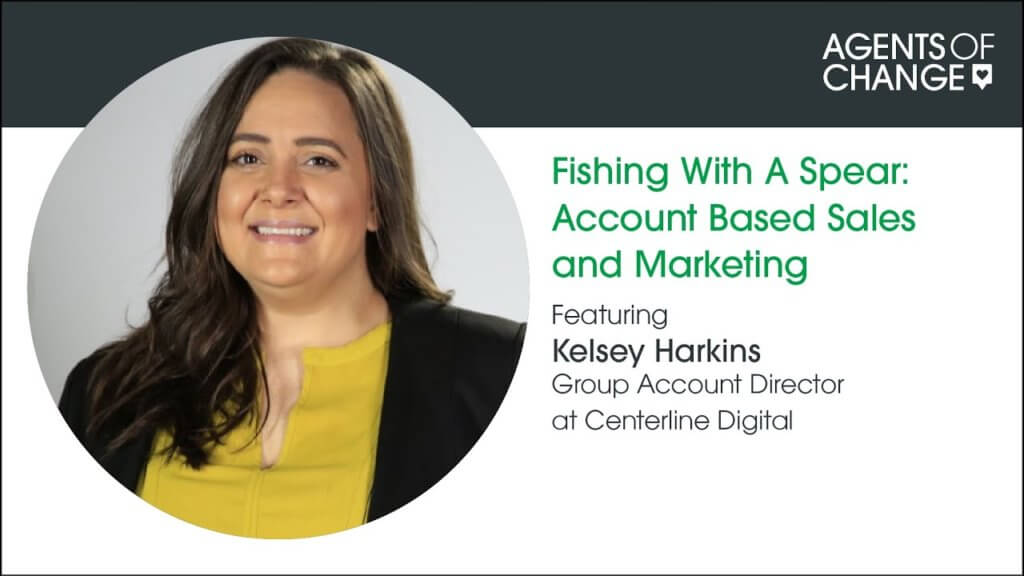As with any economic downturn we’ve ever faced, one of the most common themes surrounding current circumstances is uncertainty followed by curiosity.
Curiosity regarding what will actually happen to the economy, how it will affect specific industries, and what current trends could prove to be extremely useful in recession-proofing your organization—particularly in the B2B space.
Account-based marketing (ABM) is one of those trends that has become quite the buzzword surrounding the “doing more with less” pressure so many marketers currently face.
In a recent Agents of Change episode, Danielle O’Neil talked to Group Account Director at Centerline Digital, Kelsey Harkins, about what ABM is, what it isn’t, and how to successfully execute it alongside account-based sales (ABS).
The “What” and “Why” of ABM
Kelsey explains ABM with the perfect analogy: “It is basically fishing with a spear instead of fishing with a net.” Or, in Danielle’s words, it is marketing that targets specific accounts (one-to-one) rather than a general audience (one-to-many).
Kelsey goes on to explain that it’s a trend that has stuck and is still gaining momentum because it provides solutions for two main challenges of the modern market: ABM helps you deliver better, more customized experiences to your buyers and allows for a very targeted investment.
The average number of touchpoints to conversion has increased from 17 to 27 since the pandemic. In the wake of this challenge, ABM also offers the benefit of being able to control the exact content and messages that are being delivered to those specific prospects—shortening the sales cycle with fewer and more valuable interactions that raise your organization to the top of the “considered providers” list by the time a buyer is ready to make a purchasing decision.
What ABM Isn’t
Understanding what ABM is NOT is as important as understanding what it is when aiming to achieve its promised results.
One key point that Kelsey makes is that ABM is not industry or vertical marketing. The data from these sorts of campaigns can be very helpful in informing your content for ABM, but vertical marketing is more about the “one-to-few” approach, rather than the “one-to-one.”
“ABM is also not slapping your target account’s logo on a generic piece of content,” she goes on; even when you have a really great piece of content that seems like it would speak directly to different target accounts, ABM requires further customization and personalization that very obviously speaks directly to the specific needs of a single target account.
The Relationship Between ABM and ABS
It is extremely important for ABM and ABS to play well together in order for the account-based approach to work.
Although the actual ABS process comes in a little later down the funnel, Kesley recommends bringing on the sales team at the very beginning of ABM. Sales teams carry insight that allows for an even further personalized approach to your messaging and provides a little extra support when it’s time to see things through at the end of the cycle.
According to a Forrester buying survey, 63% of B2B purchases now have more than four people involved in the purchasing decision. Collaboration between ABM and ABS allows you to not only target the specific account but to address the needs and concerns of each person sitting on that “decision-making board.”
If you face any resistance in arranging this collaboration, focus on the win-win—on displaying the value of working together to both sides:
- Marketing can benefit from sales’ knowledge of common objections, account types that are more likely to close, common questions that come up, etc. to better target their messaging and content.
- Sales can benefit from marketing’s knowledge of the types of content their prospects are engaging with the most, what types of conversations are happening between prospects, which problems are the most emergent to address, etc. to more effectively close.
It’s important to remember, however, that it is collaboration which is vital in this relationship. And that this shouldn’t be confused with a fusion of both ABM and ABS processes.
Marketing is all about the right audience, at the right time, with the right message, and in the right channels. When you get ABM and ABS confused, Kelsey warns, at least one of those aspects tends to go wrong.
ABS is more focused on the product itself and how it answers that specific account’s problems.
If that same approach is mistakenly carried out in ABM—and you try to get too specific about the product like you would in sales—your content comes across as too much too soon. It results in wasted energy, ”particularly when targeting millennial buyers (60% of the buying audience in the B2B tech space) who prefer to do a lot of the upfront research on their own,” Kelsey points out.
What Makes a Successful ABM Campaign
Kelsey primarily looks at the engagement rate when measuring the success of an ABM campaign.
“It might seem really simple on the surface. But if you’re doing personalization and customization well in ABM campaigns, your engagement rate should improve over your other digital campaigns,” she explains.
Further down the funnel, your sales cycle length ideally should also get shorter, and your conversion rates should also improve.
ABM is a buzzword for good reason. Even with pending cookie target changes, it promises a much-needed shift that addresses both the changing buying journey and current economic uncertainty. To address these pending changes, Kelsey recommends two things:
- Use more gated content and be really smart about how you lead your prospects—making them understand that there will be value in giving away a little bit of information.
- Use contextually targeted ads; they far outperform strictly cookie targets and should be layered on even before the cookie target shift.
Are you ready to implement an ABM approach to recession-proof your organization in 2023? Let’s talk!
